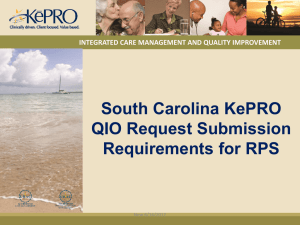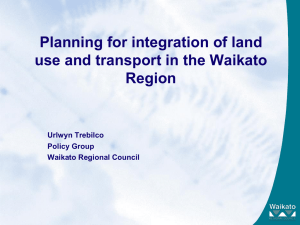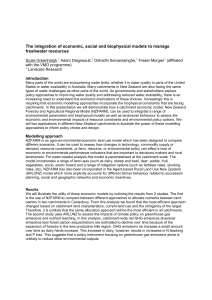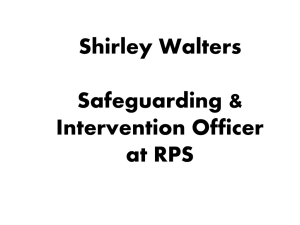New Zealand Fertiliser Manufactures* Research Association (Inc)
advertisement
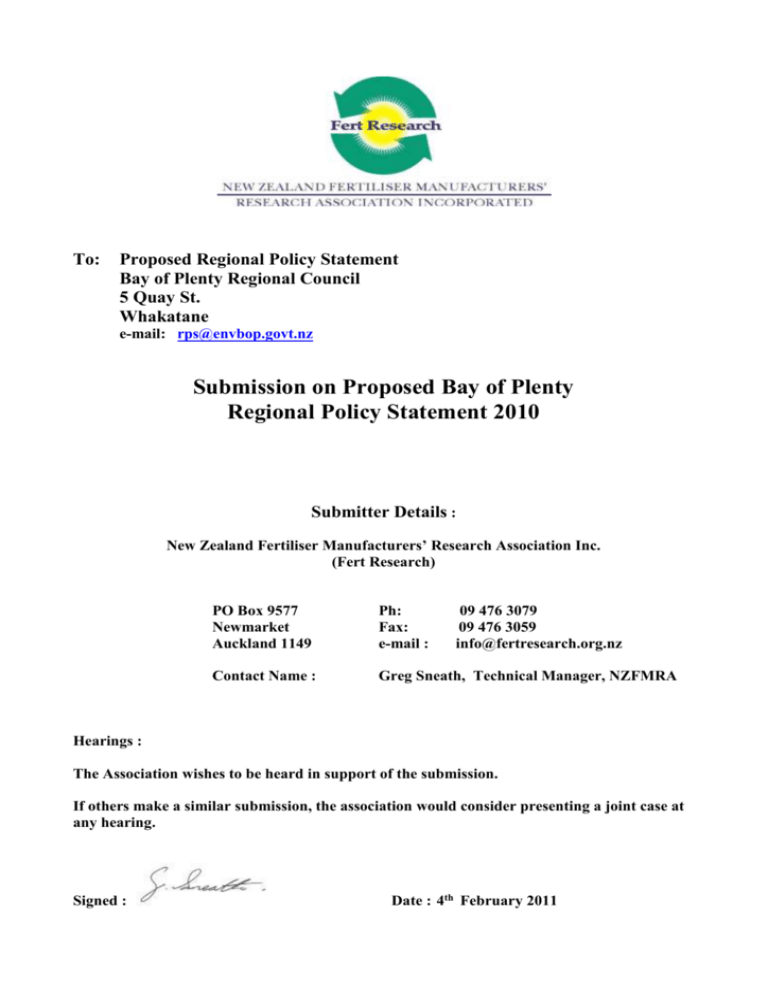
To: Proposed Regional Policy Statement Bay of Plenty Regional Council 5 Quay St. Whakatane e-mail: rps@envbop.govt.nz Submission on Proposed Bay of Plenty Regional Policy Statement 2010 Submitter Details : New Zealand Fertiliser Manufacturers’ Research Association Inc. (Fert Research) PO Box 9577 Newmarket Auckland 1149 Ph: Fax: e-mail : 09 476 3079 09 476 3059 info@fertresearch.org.nz Contact Name : Greg Sneath, Technical Manager, NZFMRA Hearings : The Association wishes to be heard in support of the submission. If others make a similar submission, the association would consider presenting a joint case at any hearing. Signed : Date : 4th February 2011 INTRODUCTION The New Zealand Fertiliser Manufacturers’ Research Association Inc (NZFMRA) is a trade organisation representing the New Zealand manufacturers of superphosphate fertiliser. The Association also operates under the name Fert Research. The Association has two member companies – Ballance Agri-Nutrients Ltd and Ravensdown Fertiliser Co-operative Ltd. Both these companies are farmer co-operatives with some 45,000 farmer shareholders. Between them these companies supply over 95% of all fertiliser used in New Zealand. The Fertiliser Industry recognises that land use and resource use in New Zealand must provide for the economic, social and cultural well-being of the community. The industry’s specific interest is in land use and resource use pertaining to agricultural production. This submission has been developed with full consultation with our member companies, Ballance Agri-Nutrients Ltd and Ravensdown Fertiliser Co-operative Ltd, and represents a joint fertiliser industry submission. We would like to thank the Bay of Plenty Regional Council for this opportunity to present a submission on the Proposed Regional Policy Statement. We welcome ongoing discussion on any points raised, and trust that are our comments are helpful in the process of amending and finalising the Proposed RPS. GENERAL COMMENTS The fertiliser industry strongly supports proactive programs and policy which encourage responsible, good agricultural practices that enable rural land use to bring economic benefits and economic security to the region while avoiding, remedying or mitigating any adverse effects of land use practices. The industry supports systems that provide flexibility for land users to engage appropriate tools and practices, which manage farm system losses, while retaining the flexibility to responsibly apply appropriate levels of the farm system inputs that are required to meet commercially viable production. Indeed this outcome is essential for the national and regional economy. The fertiliser industry continually advocates for Policy and Plan processes which: a. are output based, (i.e. targeting achievable environmental outcomes, as is consistent with the RMA, and not regulate inputs or production limits) b. maintain flexibility and encourage innovation to avoid, remedy or mitigate environmental effects, while also maintaining and developing economic, social and cultural well being. c. pursue Industry Best Management Practices, using: Codes of Practice Education programs Incentives for adoption d. encourage close collaboration and co-operation with industry bodies and sector representatives to find solutions to address land management issues e. seek catchment based environmental targets and goals, which are consistent with current and intended land use. NZFMRA Submission: EBOP Proposed RPS ; 4 Feb 2011 Page 2 SUBMISSION 1.0 Proposed RPS Structure/Style 1.1 The Proposed RPS in general and in particular section 1.6 ‘A Sustainable Region’, appears to have a strong bias towards protection and conservation. For example, section 1.6 includes the statements: “Sustainable management makes provision for the needs of future generations, ensures that fundamental resources are safeguarded and protects the environment from the adverse effects of activities” “ Whatever is in the best interests of the environment as a whole should be our guide.” 1.2 We note the Resource Management Act 1991 (RMA) does not promote protection of natural resources and other matters in preference to, or the exclusion of, development. 1.3 Sustainable management is defined within Part 2, Section 5 of the RMA as “managing use, development, and protection of natural and physical resources in a way, or at a rate, which enables people and communities to provide for their social, economic, and cultural well-being”. 1.4 The Ministry for Environment has expressed sustainability as “meeting the needs of today, without adversely impacting on the needs of tomorrow” Decision Sought 1.5 2.0 In relation to “sustainability”, greater recognition of the benefits derived from development of natural resources, including land use, must be afforded within the RPS. Water Quality and Land Use – Section 2.10.1 2.1 The fertiliser industry supports that non-point source discharges which result from land use activities should be managed through addressing outputs (system losses) in preference to limiting losses by managing land use inputs. 2.2 Addressing ‘outputs’ is consistent with managing effects under the RMA, and allows for flexibility in productive land use. 2.3 The final paragraph of section 2.10.1 appears to indicate that voluntary initiatives and other interventions, which might reduce the levels of contaminants discharged, may be restricted unless authorised by resource consent, or a rule in a plan. “Alongside the regulatory regime established in regional plans, voluntary initiatives and other interventions may directly reduce the levels of contaminants discharged. This Statement does not require that these initiatives and interventions be undertaken NZFMRA Submission: EBOP Proposed RPS ; 4 Feb 2011 Page 3 but provides the target towards which they should be directed. Such initiatives and interventions may, however, require authorization under the Act by resource consent or a rule in a plan.” 2.4 We are concerned that the Proposed RPS appears to be restricting the use of voluntary initiatives, and this could lead to perverse outcomes. 2.5 We further note that Method 77 of the Draft RPS appears to have been removed from the Proposed RPS. Draft Method 77 supported industry led environmental accords where these lead to the achievement of objectives in this Regional Policy Statement. Decision Sought 3.0 2.6 The Proposed RPS should provide for and encourage adoption of voluntary measures which comply with the Regional Plans and Rules, and reduce the effects of land use activities on water quality. 2.7 The Proposed RPS should allow for and encourage flexibility in productive agricultural land use such that “output” targets can be met by following Codes of Practice, and Best Management Practices and by engaging innovative technologies. 2.8 Re-instate Method 77: Support industry-led environmental accords and codes of practice Water Quality and Land Use – Section 2.10, Table 10 3.1 Titles of methods for this section in relation to water quality and land-use frequently lists “Regional Plan implementation” and “resource consent.” 3.2 We believe conditions of ” permitted activity status”, with regard to farming activities, provides a viable and more desirable alternative to “resource consents” to achieve the desired environmental outcomes. Conditions for Permitted activity provide greater flexibility for effectively managing diffuse nutrient management losses while maintaining economic viability. 3.3 Objective 30 of Table 10 states: “The potential of the region’s versatile land and rural production activities in the rural environment is sustained for future generations.” 3.4 Viewed in light of the context and direction provided in the RPS overview, this objective may not provide for benefits derived from the development of land, or land uses, in a way that provides for economic, social and cultural well being. Decision Sought 3.5 Amend Objective 30 as follows: “The potential of the region’s versatile land and rural production activities in the rural environment is sustained for future generations, while continuing to enable people and communities to provide for their social, economic and cultural well being.” NZFMRA Submission: EBOP Proposed RPS ; 4 Feb 2011 Page 4 3.6 4.0 Conditions for permitted activity should apply where ever possible to manage farm system losses and yet encourage flexibility, innovation and confidence in farming business development. Water Quality and Land Use – Section 3.1, Policy WL 1B 4.1 Proposed Policy WL 1B appears to provide a broad region-wide directive to facilitate land use change, and regard as a positive effect any significant reduction in contaminant discharge likely to result from land use change. 4.2 The policy explanation also provides broad examples of intensive farms discharging more nitrogen than extensive farming or forestry, while not fully identifying other significant sources of Nitrogen (or Phosphorus) 4.3 It is important to recognise that in some cases productive land use which results in more intensive farming may be entirely appropriate / acceptable to ensure economic, social and cultural well being. To phrase that another way, in some circumstances, it may be adverse to the community’s economic, social and cultural well-being to direct less intensive land use as required by this region-wide policy. 4.4 This policy is not consistent with the RMA, because it does not consider whether or not adverse effects result from the contaminant discharge. 4.5 Proposed Policy WL 1B provides only for specific circumstances, such as may occur within some iconic lake catchments. 4.6 A broad and general application of this policy, as currently proposed, may lead to perverse outcomes for the community’s economic, social and cultural well-being. 4.7 We note that Proposed Policy WL 2B defines and (in subsequent Proposed Polices) provides for specific “at risk” catchments where such a prescriptive land use policy may more suitably apply. Decision Sought 4.8 5.0 Delete proposed Policy WL 1B, as unduly prescriptive, inconsistent with the RMA and unfairly biased in the management of natural resources in a way, and at a rate, which may not enable people and communities to provide for their social, economic and cultural well being. Water Quality and Land Use – Section 3.1, Policy WL 2B 5.1 We support the definition of “at risk” catchments, for the purpose of greater control of effects on the environment. 5.2 We acknowledge that ultimately defining not only “at risk”, but all catchments within the Region should be achieved, with regard to their classification for water use and management purposes, however first priority should address sensitive “ at risk” catchments. NZFMRA Submission: EBOP Proposed RPS ; 4 Feb 2011 Page 5 Decision Sought 5.3 6.0 Include Policy that requires classification, or defining, of all catchments within the region, for water use and management purposes, recognising that first priority should address sensitive “ at risk” catchments. Water Quality and Land Use – Section 3.1, Policy WL 3B 6.1 We support the establishment of contaminant discharge limits, for at risk catchments, at a catchment or sub–catchment scale. 6.2 We understand the establishment of contaminant discharge limits to represent baselines, or the “bottom-line” referred to on page 37 of the Proposed RPS. 6.3 We further support establishing contaminant discharge limits (baselines) for all catchments within the region, with regard to their classification for water use and management purposes. Decision Sought 6.4 7.0 Include Policy that requires establishment of contaminant discharge limits for all catchments within the region, for water use and management purposes, recognising that first priority should address sensitive “ at risk” catchments. Water Quality and Land Use – Section 3.1, Policy WL 4B 7.1 This proposed policy requires that in an 'at risk catchment', changes in land-use likely to result in an increase in discharge of nominated contaminants should require resource consent. 7.2 It is not entirely clear what may be constituted as 'land use change'. The explanation provides for "land-use change, sub-division and development". For example, it is unclear whether changes to the intensity of farming or horticulture activities constitute land use change, and if so, how such change would be determined. 7.3 Using resource consents to manage discharges which give rise to a risk of adverse effects, should be restricted to land use activities which are clearly and precisely accounted for, (for example, sub-division for housing, industrial point-source or sewage discharge, or dairy effluent application to land). 7.4 Diffuse nutrient losses from farming are influenced by a range of combined farm practices, which require flexibility for change in order for a farm to remain viable. (For example, transferring winter stock, changing stock type, growing/ introducing supplementary feeds, changes in type of supplementary feeds, changes in pasture species or composition). All of these practices can influence diffuse nitrogen discharge. Resource consent to regularly change farm systems management may be unworkable and make farming businesses non-viable. NZFMRA Submission: EBOP Proposed RPS ; 4 Feb 2011 Page 6 7.5 Management of diffuse nutrient losses should allow for flexibility and innovation on farms by means of conditions of a permitted activity. For example in 'at risk catchments' nutrient discharge targets could met by engaging accredited farm systems management plans, as a condition of permitted activity. Decision Sought 8.0 7.6 This policy applies to ‘at risk catchments’ and that should be reflected in the Policy title. ( e.g. Policy WL 4B: Requiring consent for increased discharges in ‘at risk catchments’ ) 7.7 Proposed Policy WL 4B should further specify exactly which change in land use are being addressed, and specifically exclude farming systems from the definition of land use change. 7.8 If the proposed policy is intended to also manage changes in farming systems, then it should permit flexibility and certainty for land-use activities to manage diffuse farm nutrient losses by using 'accredited farm systems plans' as a condition of permitted activity, i.e. without the need for resource consent. ( a change in policy title would be required) Water Quality and Land Use – Section 3.1, Policy WL 5B 8.1 This proposed policy seeks to allocate nutrient discharge levels, within “at risk” catchments on a case-by-case basis to various land use activities. 8.2 It is unclear exactly how this policy will be given effect. Will it apply to all land use activities - consented and permitted, existing and new? 8.3 It is difficult to provide meaningful feedback on this policy without understanding how it is to be applied Decision Sought 8.4 The proposed policy should be amended to identify exactly which land use activities are to receive allocation of nutrient discharge levels. 8.5 9.0 If the proposed policy is intended to manage nutrient discharges from farming systems, then it should permit flexibility and certainty to manage diffuse nutrient losses by using 'accredited farm systems plans' as a condition of permitted activity, i.e. without the need for resource consent and by managing system losses not system inputs. Water Quality and Land Use – Section 3.1, Policy WL 6B 9.1 This proposed policy seeks to reduce nutrient discharge levels, within “at risk” catchments where the total nutrient discharges are in excess of the total discharge limits established for the catchment under proposed policy WL 3B. NZFMRA Submission: EBOP Proposed RPS ; 4 Feb 2011 Page 7 9.2 It is not clear how this policy provides anything in addition to Policy WL 3B. Policy WL3B establishes a limit on specific contaminants that can be discharged in to catchments at risk. 9.3 The explanation to the proposed policy identifies the land-use activity of dairying as one such activity that may require reduction. 9.4 It is unclear exactly how this proposed policy will be given effect. Will it apply to all land use activities - consented and permitted, existing and new? Decision Sought 10.0 9.5 The proposed policies WL 3B and WL 6B should be amended to clarify how they are to be applied. ( e.g. If WL3B applies to catchment or sub-catchment scale losses, and WL 6B applies to property scale losses, then that should be clearly stated.) 9.6 The proposed policy should be amended to identify exactly how land use activities are to be managed to reduce nutrient discharges. 9.7 If the proposed policy is intended to manage nutrient discharges from farming systems, then it should permit flexibility and certainty to manage diffuse nutrient losses by using 'accredited farm systems plans' as a condition of permitted activity, i.e. without the need for resource consent. 9.8 The policy to reduce nutrient losses should also specifically provide for protecting long term economic, social and cultural well-being in addition to meeting discharge limits. Water Quality and Land Use – Section 3.1, Policy WL 8B 10.1 This proposed policy requires regular reviews to take into account advances in science and technology. 10.2 This approach should apply only to 'at risk’ catchments and must be carefully balanced to ensure business certainty and confidence for growth and development of industry within the region. 10.3 Flexibility in being able to responsibly manage output (losses), which may have an adverse effect on the environment is supported, however, regular review, or potential change to consent conditions prevents certainty for business investment. Flexibility to adopt and engage in new technologies and industry best practices, using conditions for permitted activity may provide one means of achieving environmental outcomes, and maintain business confidence for investment. Decision Sought 10.4 Amend the proposed policy to only apply to land use activities within 'at risk’ catchments. NZFMRA Submission: EBOP Proposed RPS ; 4 Feb 2011 Page 8 10.5 11.0 Specific provision should be made to ensure that certainty for business investment is protected. Water Quality and Land Use – Section 3.1, Policy WL 9B 11.1 Proposed Policy WL 9B fails to acknowledge support facilities and infrastructure (such as fertiliser storage and despatch facilities) that are required to be in close proximity to where agriculture and horticulture occurs. Decision Sought 11.2 12.0 Amend the proposed policy to acknowledge that from time-to-time rural processing and storage facilities need to be located in close proximity to where agriculture and horticulture occurs. Part 4 - Table: Objectives, anticipated environmental results, monitoring indicators Water quality and land-use objective 26 - 30 12.1 Part 4, Monitoring the Regional Policy Statement and the anticipated environmental results, sets out the procedures to be used to measure and monitor the efficiency and effectiveness of policies and methods in the Statement, and the extent to which they are achieving the objectives. 12.2 The [unidentified] table in Part 4, sets out the objective, anticipated environmental results and monitoring indicators of the Regional Policy Statement. 12.3 While social and environmental indicators appear to be well provided for, monitoring of the Regional Policy Statement does not appear to include indicators for the economic success or failure of the RPS. Decision Sought 12.4 13.0 Monitoring indicators should also include a measure of impact of the RPS on economic wellbeing. Part 4 – Table: Objectives, anticipated environmental results, monitoring indicators Water quality and land-use objective 27 and 29 13.1 Objectives 27 and 29 list as a measure of the Regional Policy Statement’s success, indicators based on surveys that show 80 percent of people perceive water pollution is not a problem, and 80 percent are satisfied land use is in harmony with its environment. 13.2 These indicators are highly emotive and prone to misconceptions. 13.3 These indicators do not necessarily provide a good measure of sound resource management for the economic, social and cultural well being of a region, nor do they NZFMRA Submission: EBOP Proposed RPS ; 4 Feb 2011 Page 9 necessarily provide a good measure of the actual environmental outcomes and achievement of these objectives. Decision Sought 13.4 Delete monitoring indicators that refer to perception or satisfaction by 80 percent of regions residents/people, and utilise objective (rather than subjective) indicators. End . NZFMRA Submission: EBOP Proposed RPS ; 4 Feb 2011 Page 10
